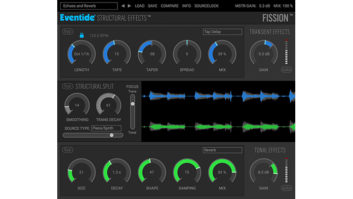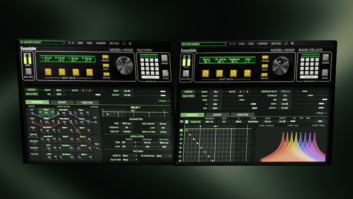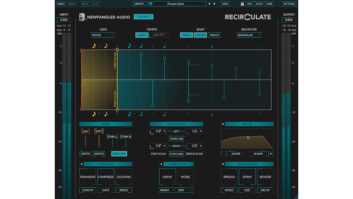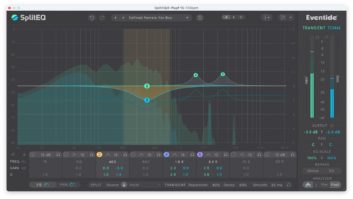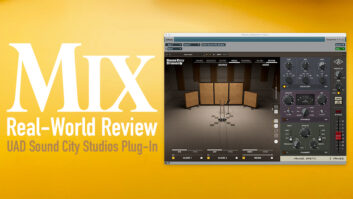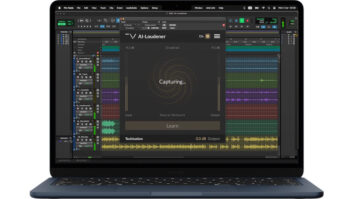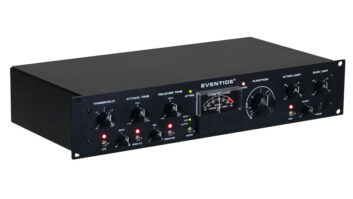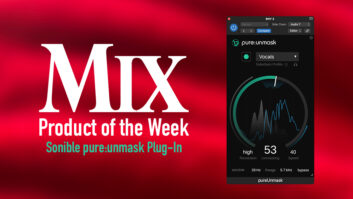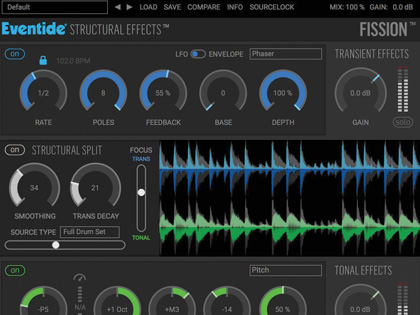
Fission is Eventide Audio’s first plug-in to feature the company’s patent-pending Structural Effects meth.odology for splitting audio, disassembling it into two fundamental components called Transient and Tonal. Able to be recombined completely in any balance, the Transient and Tonal components are available for individual processing us.ing Fission’s Transient Effects and Tonal Effects. The plug-in sup.ports mono/stereo VST, AU, AAX, Mac OS 10.7+ and Windows 7 / 8.
The Structural Split Section resides in the center of the plug-in’s GUI with the Transient Effects and Tonal Effects processor sections, respectively, above and below it.
The Structural Split core engine of Fission uses a frequency and time domain “sieve” to filter sound not by frequency but by its in.trinsic waveform shape. Sustaining audio that seems stable and pre.dictable, and whose waveforms have rounded and smooth curves, are characterized as Tonal. Audio that is unpredictable—i.e., fast dynamic peaks and jagged rise times—is characterized as Transient.
The process of tonal/transient separation begins by selecting any of 13 different coarse algorithmic tunings called Source Types. The incoming audio is then chopped into approximately 40ms frames and analyzed, frame-by-frame, to determine what portions of the audio stream are tonal, leaving the rest as transient. The 13 Source Types are: Kick, Snare, Tom, Cymbal, Full Drum Set, Electronic Beat, Hand Drum, Per.cussion Set, Bass, Piano/Synth, Guitar, Vocal and General (default position).
Structural Split has two separate color-cod.ed real-time waveform displays parading left to right that depict audio signals post–Structural Split but before the effects sections. The tran.sient component is blue with the tonal content shown in gray, and the tonal component is shown in green, each of which is overlaid on top the un-split original signal in gray.
I found that setting up the Structural Split first for a particular source was the best way to begin using Fission. With the Transient and Tonal effects sections switched off and their (always on) Output makeup gain controls set at unity, the Structural Split section’s action can be heard, adjusted and used on its own if desired.
Splitting artifacts might in.clude low-level flanging/phas.ing “burbles” mostly notice.able on fading sustains—room ambience, reverb or ring-outs of the separated Transient au.dio. But I would add that as soon as you recombine nearly any amount of the Tonal back into the mix, these artifacts are not heard. Selecting a different Source Type, adjusting the Fo.cus fader and/or the Smooth.ing and Trans Decay controls will minimize these artifacts.
The Focus fader crossfades the output of the Structural Split section to either the Transient or Tonal ef.fects sections of Fission. I found the optimum Focus position was near or exactly in the middle of its range for equally splitting audio, in both time and pitch, into separate Transient and Ton.al components. The Smoothing control slows the fast, back-and-forth transitions in time and pitch between the Transient and Tonal audio streams. Additionally, turning up the Trans Decay control will constrain how quickly audio transitions from Transients to Tonal, but not back again like Smoothing. The Transient Effects section has six processors selectable from a pull-down menu: Delay with Warp on/off; Tap Delays (up to 32 taps); Dynamics (compressor/limiter and expander/gate); a 32-pole Phaser with both LFO and envelope modulation; a high-density Reverb with basic controls; and Gate + EQ, a gate followed by a three-band EQ de.signed to be easily overloaded. The seven Tonal Effects section are more pitch-based effects: Delay with Warp and voice chorusing modulation; Compressor/Limiter; a three-voice Pitch Shifter with a ± one-octave range and micro pitch chorusing/doubling; a multi-voice Chorus with randomized modulation; a low-density Reverb; Tremolo with both LFO and envelope modulation; and finally, my favorite, a colorful three-band equalizer with a fully parametric midrange section. Both the Transient and Tonal Effects sections have global controls for session tempo sync on/off, subdivision choices and modulation sources for the envelope follower and LFO. There is also an effect On/Off button (not mute), Out.put Gain controls with a -96 to +18dB range, Solo but.tons, and Output meters that are post-effect and Gain. To get started, Fission comes with 22 banks of presets listed by Instruments, Effects, Mixing, and Artists—well-known performance and recording art.ists. After I would first optimize Structural Split on the particular instrument or voice, I liked the Source Lock feature so that Structural Split setup would not change while auditioning presets. I started with frequency shifting a rack tom track down in pitch. I’ve done this before with frequency shift.ing plug-ins and hardware, but the problem has always been that the attack—the sound at the moment the stick hits the drum—is also shifted, resulting in a flabby over.all sound. I pulled down the Snare Source Type, used the gate section of the Gate + EQ processor in Transient Effects and the Pitch processor in Tonal. With Focus to.ward Tonal, the drum’s attack transient hard-gated (in Transient) and the tom pitched a down a 4th (in Tonal), I got a deep, more natural tom sound. I especially liked Fission’s bowed instrument pre.sets that will change a (normally) picked, struck or plucked instrument into a whole new expressive voice for my mixes. I’ve developed presets for piano, acoustic guitar and electric guitar. On a bright acoustic guitar track, while soloing the Tonal side and moving the Focus fader toward Transient, I could hear more and more of the transient component removed from the Tonal Effects processor. The Transient and Tonal section’s solo but.tons are X-OR, non-latching—so it’s easy to audition back and forth between the two pro.cessors. (FYI: the solo button’s state and more than 100 of Fission’s parameters are automat.able and saved with a preset.) I used the Tonal compressor heavily with a medium release time, super-fast attack and Smoothing at 0. With the Focus fader just above the center position toward Transient, I fine-tuned Trans Decay so that a fingerpicked acoustic guitar part sounded completely reversed—but this is just one of many variations possible. Electric guitars (depending on the part and original recording) can be made to sound like a pedal steel with perfect volume pedal swells. As I have been experimenting with Fission, I’ve come to realize that this is an incredibly well-thought-out processing system! Part sound design and part very musical audio processor, Eventide Audio’s Fission offers a way to rebalance a sound source’s fundamental nature and timbre with its facile manipulation of time, frequency, and amplitude. Super-exciting and awe.some, and I’m highly recommending. n Barry Rudolph is an L.A.-based engineer and educator. Visit him at www.barryrudolph.com.
The Fission plug-in separates audio into Transient and Tonal components for separate processing.
PRODUCT SUMMARY
COMPANY: Eventide Audio WEB: eventideaudio.com/fission
PRODUCT: Fission Structural Effects Plug-In
PRICE: $179 MSRP PROS: A whole new palette of processing power from subtle to extreme.
CONS: Occasional splitting artifacts in this 1.0 version.
TRY THIS
Fission also works as a pair of parallel processors. With the Structural Split section turned off, the Focus fader now becomes a Send fader to route audio into both the Transient and Tonal Effects at the same time. For a tympani roll that I wanted to sound otherworldly, I set the Transient Effects to Phaser and used enve.lope modulation triggered from tympani’s input. I blended a little of the Chorus effect from Tonal to make the sound more myste.rious. Even though the two processors are not available separately for panning left and right, the two time-based effects I just described did add a lovely motion to the mono tympani track! Great fun!
